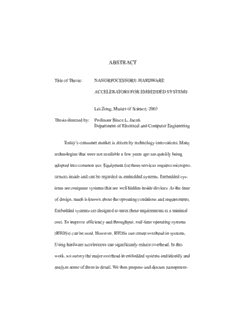
Nanoprocessors: Configurable Hardware Accelerators for Embedded PDF
Preview Nanoprocessors: Configurable Hardware Accelerators for Embedded
ABSTRACT Title of Thesis: NANORPOCESSORS: HARDWARE ACCELERATORS FOR EMBEDDED SYSTEMS Lei Zong, Master of Science, 2003 Thesis directed by: Professor Bruce L. Jacob Department of Electrical and Computer Engineering Today’s consumer market is driven by technology innovations. Many technologies that were not available a few years ago are quickly being adopted into common use. Equipment for these services requires micropro- cessors inside and can be regarded as embedded systems. Embedded sys- tems are computer systems that are well hidden inside devices. At the time of design, much is known about the operating conditions and requirements. Embedded systems are designed to meet these requirements at a minimal cost. To improve efficiency and throughput, real-time operating systems (RTOSs) can be used. However, RTOSs can create overhead in systems. Using hardware accelerators can significantly reduce overhead. In this work, we survey the major overhead in embedded systems and identify and analyze some of them in detail. We then propose and discuss nanoproces- sors, as configurable hardware accelerators, to lower this system overhead. Our simulation result shows that nanoprocessors can improve system per- formance at a nominal cost. NANOPROCESSORS: CONFIGURABLE HARDWARE ACCELERATORS FOR EMBEDDED SYSTEMS by Lei Zong Thesis submitted to the Faculty of the Graduate School of the University of Maryland, College Park in partial fulfillment of the requirements for the degree of Master of Science 2003 Advisory Committee: Professor Bruce L. Jacob, Chair Professor Manoj Franklin Professor Donald Yeung ©Copyright by Lei Zong 2003 DEDICATIONS To Luke, thanks for sharing the experience. ii ACKNOWLEDGEMENTS I would like to thank my advisor Dr. Bruce Jacob for his advice and help during the past couple of years. I have learnt a great deal from him. I would also like to thank everyone in the SCAL computer lab. You made it a fun experience for me. iii TABLE OF CONTENTS List of Tables.............................................................. vii List of Figures ........................................................... viii 1 Introduction...................................................................9 1.1 Overview.................................................................................9 1.2 Background Information.......................................................10 1.2.1Modern Embedded Systems............................................10 1.2.2Real Time Operating Systems.........................................13 1.3 Nanoprocessors.....................................................................16 1.4 Related Work.........................................................................20 2 Overheads in Embedded Systems ...............................24 2.1 High-Overhead Serial Input/Output(I/O) Port......................24 2.2 Process Scheduling Overhead in Embedded RTOS..............26 2.2.1Task Scheduling...............................................................26 2.2.1.1Static Scheduling.......................................................27 2.2.1.2Dynamic Scheduling.................................................28 2.2.2Overhead of Dynamic Scheduling...................................32 3 Nanoprocessors as reconfigurable logic......................34 3.1 Overall System Design..........................................................34 3.2 Reconfigurable Logic............................................................37 4 Nanoprocessor as I/o controller...................................40 4.1 High-Level Functional Description.......................................40 4.2 Design Issues.........................................................................42 4.3 NanoI/O Controller Interface................................................45 4.4 Implementation Details.........................................................48 iv 5 Nanoprocessor as a task scheduler..............................55 5.1 System Design.......................................................................56 5.2 High-Level Functional Description.......................................57 5.2.1Software Scheduler Functionality....................................57 5.2.2NanoScheduler Functionality..........................................64 5.3 NanoScheduler Task Structure..............................................67 5.4 NanoScheduler Interface.......................................................71 5.5 Implementation Details.........................................................73 6 Experimental methods.................................................84 6.1 Performance Simulator..........................................................84 6.1.1Processor..........................................................................85 6.1.2Operating System.............................................................87 6.1.2.1Processor Scheduling.................................................88 6.1.3Benchmarks.....................................................................89 6.1.3.1ADPCM.....................................................................90 6.1.3.2GSM..........................................................................90 6.1.3.3Patricia.......................................................................91 6.1.3.4Dijkstra......................................................................91 6.1.3.5SHA...........................................................................91 6.1.3.6Bitcount.....................................................................92 6.1.3.7G721..........................................................................92 6.1.3.8Homemade Benchmark.............................................92 6.1.4Tasks................................................................................93 6.1.5Measurements..................................................................93 6.2 Cost Simulator.......................................................................95 7 Results for nanoprocessor as i/o controller ...............101 7.1 System Bandwidth Analysis...............................................101 7.2 Processor Utilization Analysis............................................106 7.2.1Future Optimization.......................................................110 7.3 NanoI/O Controller Cost.....................................................113 7.3.1Die Area Analysis..........................................................113 v 7.3.2Power Consumption Analysis........................................115 8 Results for nanoprocessor as scheduler.....................118 8.1 Schedulability Analysis.......................................................118 8.2 System Bandwidth Analysis...............................................122 8.3 Processor Utilization Analysis............................................124 8.4 Die Area and Power consumption Analysis........................129 9 Conclusion.................................................................131 9.1 Summary.............................................................................131 9.2 Future Work.........................................................................134 Bibliography..............................................................136 vi LIST OF TABLES Table 4.1:I/O Operation Overhead as a Function of the Requested Data Size.....................................................................................41 Table 5.1:Functionality of the OS with the nanoScheduler for handling task state transitions............................................................64 Table 5.2:NanoScheduler Data Structure Fields and Their Explanations70 Table 6.1:Synthesis Conditions...............................................................97 Table 6.2:Switching Probability of a NAND and a NOR gate...............99 Table 6.3:Power-Specific Unit Parameters.............................................100 Table 7.1:Area Estimate for the nanoI/O Controller................................115 Table 7.2:Power Estimates for the nanoI/O controller.............................116 Table 8.1:Die Area Estimate for Hardware Scheduler.............................129 Table 8.2:Power Consumption Estimate for Hardware Scheduler..........130 vii
Description: